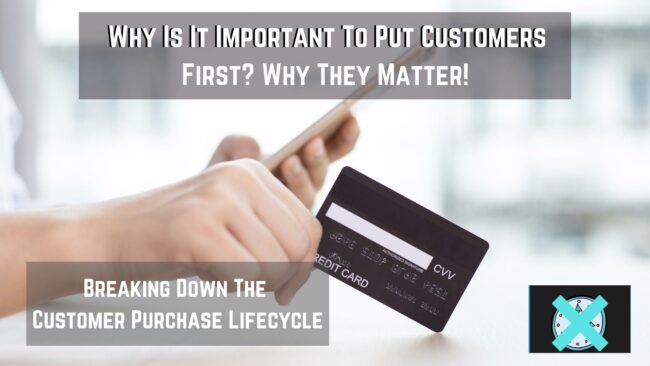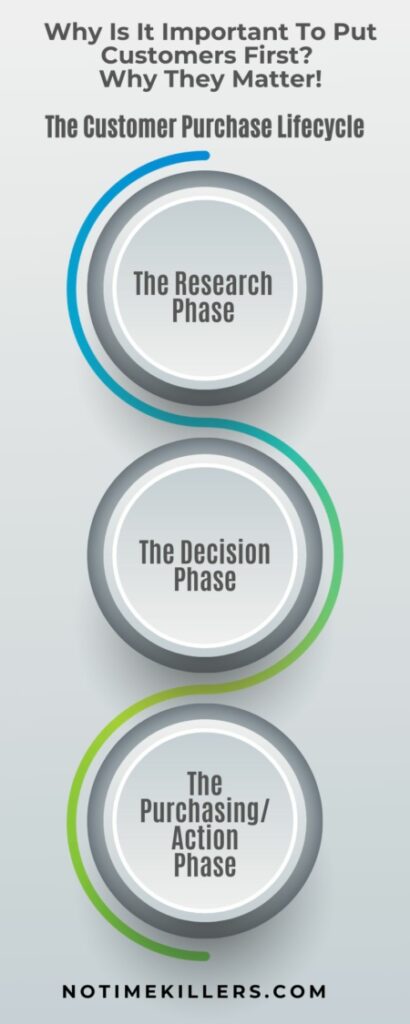In the world of online marketing, why is it important to put customers first? Why do they need to be prioritized?
When you put customers first, you build trust, create loyalty, and, most importantly, you establish a sustainable competitive advantage for your business.
This customer-centric approach not only leads to satisfied customers but also drives business growth and profitability.
This understanding, often referred to as “customer comprehension,” is the cornerstone of any profitable business.
It’s not just about knowing what your customers want. But also understanding their behaviors, motivations, and the journey they take from discovering a product to making a purchase.
This journey is known as the Customer Purchase Lifecycle.
Let’s dive into this process much further. Along with that, I’ll go over effective ways how to do that in online business.
Note: We may include products or services that will be helpful to our readers. This post may contain affiliate links. For more information, please review the affiliate disclosure page.
- Understanding Customer Comprehension
- The Phases Of The Customer Lifecycle
- The Research Phase
- The Decision Phase
- The Purchasing/Action Phase
- The Importance Of Understanding Your Customer

Why Is It Important To Put Customers First?
Putting customers first is crucial in any business because it builds trust, creates loyalty, and establishes a sustainable competitive advantage. When you prioritize your customer’s needs, you not only create satisfied customers but also drive business growth and profitability.
Understanding Customer Comprehension
Before you can effectively sell anything online, you need to first determine who your customer is, what they often purchase, and why they are purchasing online.
It’s a common mistake to promote a product or service to a customer before fully understanding them.
Customers rarely buy on their first point of contact with a product. It typically takes a person seven interactions before they make a purchase online.
Therefore, understanding your customer is not just beneficial, it’s essential for success. To learn more about this process, I encourage you to check out this lesson breaking down customer comprehension.
My own perception as a customer
I can relate to that because, for the most part, I usually don’t jump in and buy something when I first discovered it.
For me, I like to do some research and read reviews before purchasing a product or service.
It helps to ensure that what I buy is worth purchasing and that I’ll make good use of it as well.
What Is The Most Important Aspect of Customer Success?
The most important aspect of customer success is ensuring that your products or services deliver value and meet your customers’ needs. That involves understanding your customers’ needs, preferences, and behaviors tailoring your products, services, and customer support to meet these needs.
The Phases of the Customer Lifecycle
The Customer Purchase Lifecycle can be broken down into three key stages:
- The Research Phase
- The Decision Phase
- The Purchasing/Action Phase.

The Research Phase
This is the initial stage where customers are gathering information about a product or service.
They may not have product awareness yet, and they’re hungry for information.
At this stage, it’s important to provide comprehensive and accurate information about your product or service to guide them toward making an informed decision.
The Decision Phase
At this stage, customers have gathered enough information and are deciding which product or service best suits their needs.
They’re likely looking for product reviews or further product insight.
This is where your role as a marketer becomes crucial. You need to provide clear, concise, and compelling reasons why your product or service is the best choice.
The Purchasing/Action Phase
This is the final stage where customers are ready to make a purchase. They’ve done their research, made their decision, and are now fully prepared to buy.
At this point, it’s crucial to have a seamless and straightforward purchasing process to ensure a positive customer experience.

The Importance of Understanding Your Customer
To truly understand your customer, you need to answer ‘yes’ to the following questions:
- Do you read a lot about your niche?
- Can you effectively communicate with others in your niche?
- Do you understand the core problems within your niche?
If you answered ‘no’ to any of these questions, you might want to consider whether you want to change your niche or not.
Keep in mind that you want to pick a niche that you’re genuinely interested in. It helps to pick one that you feel passionate about.
Should The Customer Needs Come First?
Absolutely. Customer needs should always come first in a business. Understanding and meeting your customers’ needs is the key to creating products and services that they value. When you prioritize your customer’s needs, you enhance customer satisfaction, foster customer loyalty, and ultimately drive business success.
Leveraging Company Advertising & Branding
Company advertising can be a powerful tool to drive your online business.
People who see advertising offline are likely to be much further along in the purchasing lifecycle.
By using product review-type keywords, as well as purchase keywords, you can take advantage of company advertising and attract customers who are already familiar with a brand.
Finding the Right Keywords
Using product-related keywords in your advertising can be highly effective.
People who search product-related keywords are typically very far along in the purchasing lifecycle because they are already knowledgeable in the subject area
Also, they’ve already been exposed to some form of branding or advertisement.
Learning from Your Own Purchasing Habits
By reflecting on your own purchasing habits, you can gain valuable insight into how customers become buyers.
Reverse engineering your own customer activity can provide a lot of insight into the purchasing process.
Creating Long-Term Customers
The customer purchase lifecycle doesn’t end with the initial purchase. In fact, it’s easier to sell to an existing customer than to a prospective one.
By maintaining and organizing customer relationships, you can create long-term customers and ensure the continued success of your business.
For more information on customer behavior and marketing strategies, check out this comprehensive guide.
A relevant article from notimekillers.com
Read next on “How Can I Spread The Word About My Business? By Talking” to learn a proper way to grow your business. Simply put, it can be by talking to others in person.
Final Words
Putting customers first means understanding their journey from the initial research phase, through the decision-making process, to the final purchase, and even beyond.
Remember, the relationship with a customer doesn’t end with a single purchase.
By maintaining and organizing customer relationships, you can create long-term customers and ensure the continued success of your business.
In essence, putting customers first is not just a marketing strategy—it’s a business philosophy that leads to success and profitability.
By understanding and implementing the concepts discussed, you’ll be well on your way to creating a customer-centric business that thrives in the online marketplace.
Looking for a different route with massive potential?
If you’ve resonated with this article and are considering venturing into entrepreneurship, I have an excellent resource for you to explore.
Wealthy Affiliate is a modernized platform designed to support aspiring entrepreneurs like you on your journey.
As a Wealthy Affiliate premium member, you get help in three effective approaches:
- Core training modules: Wealthy Affiliate provides foundational training in four simple steps:
- Choosing a niche you’re passionate about.
- Building a straightforward and effective website.
- Acquiring free traffic to your site.
- Generating revenue from your online presence.
2. One LIVE weekly expert class: Every week, there’s a live expert class providing the latest tips and strategies to grow your online business – strategies that are working right NOW in the ever-evolving digital landscape.
3. Private messaging and mentorship: What truly sets Wealthy Affiliate apart is the personalized support you receive. That includes private messaging and direct assistance from myself and the co-founders. You get the chance to work directly with “the CEOs,” receiving first-hand advice from those who’ve been successful in this field.
I encourage you to sign up for a free starter account with Wealthy Affiliate. Give it a test drive, explore its features, and see how it can potentially transform your entrepreneurial journey.
You can upgrade to a premium account when ready to unlock even more resources and benefits.
You have nothing to lose and everything to gain. Let Wealthy Affiliate be your guide as you step into entrepreneurship.

Your Turn: Do you believe prioritizing customer needs is essential?
I would like to get some feedback from you. Here’s some food for thought:
- How do you ensure that you’re putting your customers first in your business?
- Do you have any specific strategies or practices that you’ve found to be effective?
- What challenges have you faced in trying to understand and meet your customer’s needs, and how have you overcome them?
Feel free to share your thoughts by leaving a comment below. I look forward to reading your responses, and I’ll gladly respond promptly.
If you got value from this article, please bookmark this website to visit later for new posts every week. Spread the word to others. Sharing is caring! To get more of this type of content, you won't want to miss out my daily email letters. These are worth some golden nuggets and best tips to help you in your business. Sign up today! Count me in on the daily letters via email! For the latest videos that come out every week, subscribe to the YouTube channel. Also, be sure to check out our new space on Twitter X! YouTube Twitter (X) Medium Profile
Eric is the owner and chief editor of notimekillers.com. He takes great pride in helping people manage their time and grow their businesses. Eric is a firm believer in financial and time freedom, as he believes in financial independence and taking ownership of your time. “Time is your most important asset. It can be your best friend or worst enemy. How you use your time can shape the future you desire to have.” In his leisure time, Eric loves to write and read whenever possible. He enjoys going for long walks outdoors while doing in-home workout videos every week. You can also connect with Eric via LinkedIn.


The points about the different phases of the Customer Purchase Lifecycle are interesting, but I’m wondering how businesses can strike a balance between providing information and not overwhelming customers. Especially in the Research Phase, how can they ensure they’re offering enough details without turning customers away due to information overload?
Hi Ashley,
Great question! To strike a balance:
-Have layered information: Offer a brief summary first, with options for deeper details. This lets customers choose their depth of information.
-Give visual aids: Use infographics or videos to convey details in a digestible manner.
-Provide feedback: Regularly ask for customer feedback on content to ensure it’s neither too sparse nor overwhelming.
The key is to guide, not inundate, during the Research Phase.
I hope that helps. Thank you for asking those questions- they’re greatly appreciated.